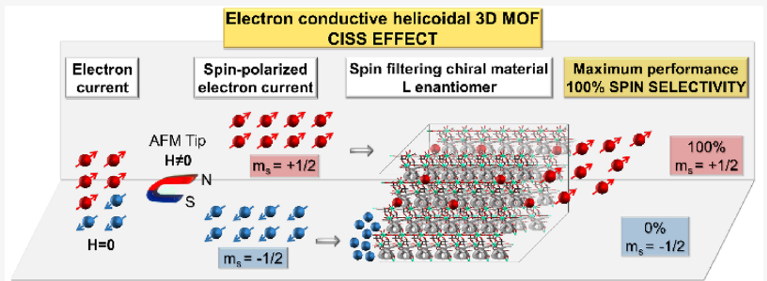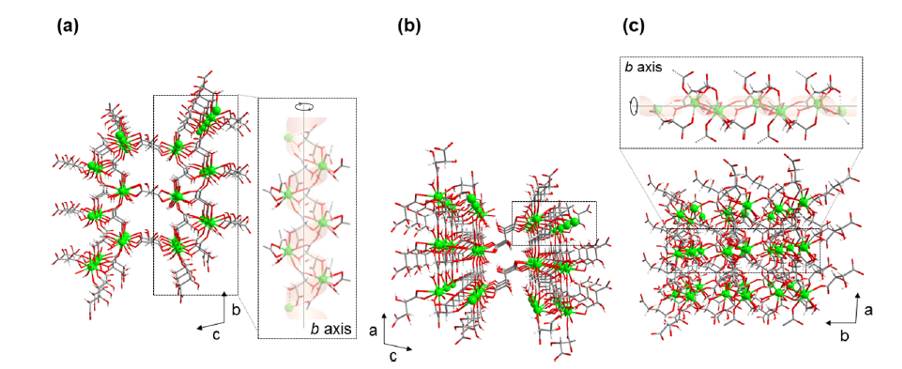A 3D metal-organic framework as ideal electron spin filter

During the last decades, the electronics industry has been very successful in pushing forward the advancement of electronic building blocks, but the limit of silicon-based electronic devices especially in terms of miniaturization are almost reached. There are many ideas how to overcome this problem, for example, by adding functionality based on approaches originating from molecular electronics, quantum electronics, or atomic scale spintronics.
In spintronics, new memory and logic devices are being developed based on the use of spins of nuclei, atoms, or molecules, instead of electronic charges. The main advantages are an improved energy efficiency and speed of operation to store and process information.
The generation of spin currents reported in the literature is mainly limited to magnetically active materials and spin-active interfaces. The spin polarization power of the former type of materials, such as transition metal ferromagnets and their alloys, is only moderate (up to 45%), and alternative materials have been proposed as promising spin filters with varying performance.
On the other hand, electron transport in chiral systems exhibits a number of remarkable features having to do with the fact that the spin–orbit interaction induces a coupling between the angular momentum and the spin of electrons, which translates into the appearance of spin polarization and spin filtering. The phenomenon is called electron dichroism as, in many ways, it is the equivalent of the better-known optical dichroism effect. In the latter, it is the rotation of the plane of polarization of the magnetic and electric components of the electromagnetic field that is experimentally measured, whereas the former corresponds to the polarization of the electronic spin.
The phenomenon is also known as chirality-induced spin selectivity (CISS), inferring that the transport of one of the electronic spins is facilitated over the other in a chiral structure. After the discovery of CISS effect in 2012, it is now well established that chiral molecules can work as efficient filters for electron spin, transmitting preferentially one spin component over the other in processes involving electron transfer, electron transport, and electron transmission. Such is the case of self-assembled chiral monolayers composed of helical DNA, oligopeptides, helicenes, and cysteine-capped-CdSe chiral quantum dots. These nonmagnetic chiral materials are being implemented in CISS-based spin devices, since they can show large room temperature magnetoresistance.
The spin polarization power of such diamagnetic chiral conductive (bio)molecules has been measured using various types of experimental setups, which are usually designed to measure the differential current intensity transmitted through a chiral system when either the direction of magnetization is reversed or, alternatively, when a polarized electron current flowing in one particular direction is injected through two enantiomers of the same system. Different enantiomers of the same chiral system have been reported to transmit preferentially one electron spin component over the other, with spin polarization power values ranging from 5 to up to an 85%.
3D metal-organic frameworks (MOFs) are high dimensionality nanostructured materials where organic molecules are intercalated within a complex structure involving metal atoms. Now, a team of researchers report 1 , for the first time, on the performance of a MOF as a spin filtering material.

MOFs are well-known potentially porous materials that have been intensely studied during the last decades for their versatile structural architectures derived from their modular constituents: metal ions or clusters and organic ligands. MOFs can inherit the properties of both structural components, e.g., metal and ligands, and benefit from their interplay to optimize their performance in applications in different fields. In this regard, the use of MOFs in spintronic devices and as electrical conductors are two emerging fields that, though still in their infancy, offer the opportunity to develop materials with outstanding properties compared to their inorganic analogues.
The team selected a hybrid organic−inorganic material based on Dy(III) ion and 2R,3R-dihydroxybutanedioate, a chiral ligand with two stereogenic carbons. The corresponding MOF is part of a larger family of isostructural pairs of enantiomeric MOFs, which consist of enantiomerically pure 3D microporous, water insoluble, thermally stable, (chiro)luminescent, and paramagnetic MOFs.
This MOF is proved to behave as an almost ideal electron spin filtering material at room temperature, transmitting one spin component only, leading to a spin polarization power close to 100%, conserved over a long spatial range, larger than 1 μm in some cases.
This impressive spin polarization capacity is measured by means of magnetically polarized conductive atomic force microscopy and is attributed to the CISS effect of the material arising from a multidimensional helicity pattern, the inherited chirality of the organic motive, and the enhancing influence of Dy(III) ions on the CISS effect, with large spin−orbit coupling values.
These results represent the first example of a MOF-based and CISS-effect-mediated spin filtering material that shows a nearly perfect spin polarization. These striking results obtained with a robust and easy-to-synthesize chiral MOFs constitute an important step forward in the improvement of spin filtering materials for spintronic devices.
Author: César Tomé López is a science writer and the editor of Mapping Ignorance
Disclaimer: Parts of this article may be copied verbatim or almost verbatim from the referenced research paper.
References
- Uxua Huizi-Rayo, Junkal Gutierrez, Jose Manuel Seco, Vladimiro Mujica, Ismael Diez-Perez, Jesus M. Ugalde, Agnieszka Tercjak, Javier Cepeda, and Eider San Sebastian (2020) An Ideal Spin Filter: Long-Range, High-Spin Selectivity in Chiral Helicoidal 3-Dimensional Metal Organic Frameworks NanoLetters doi: 10.1021/acs.nanolett.0c02349 ↩